The Frayer Model is an instructional strategy widely used in classrooms to enhance vocabulary learning and comprehension. Whether you’re teaching complex scientific terms or abstract concepts, the Frayer Model provides a systematic way to help students grasp and retain new vocabulary effectively.
What are the Four Parts of the Frayer Model?
The Frayer Model is structured around four quadrants, each serving a specific purpose in enhancing understanding:
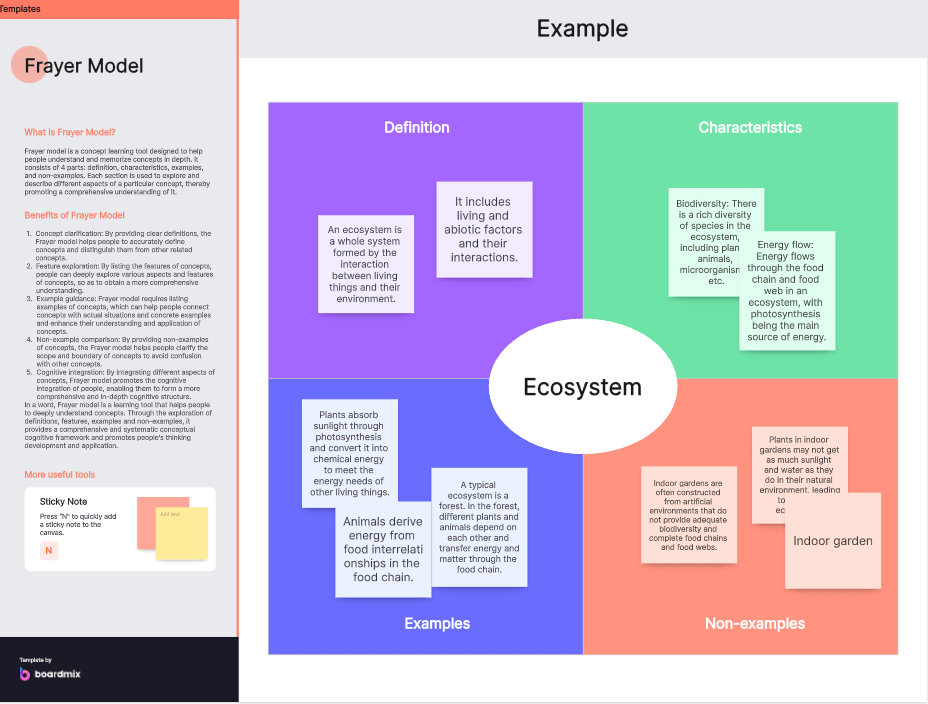
1. Definition
This quadrant is dedicated to defining the target word. Students write a clear and concise definition of the term, which helps in solidifying their understanding. The definition should be in the student's own words, allowing them to internalize the meaning.
2. Characteristics
Here, students list the key characteristics or features of the word. This may include attributes, qualities, or specific details that are associated with the term. For example, if the word is "photosynthesis," characteristics might include "process in plants," "requires sunlight," and "produces oxygen."
3. Examples
In this section, students provide examples of the word in context. These examples can be sentences, scenarios, or instances where the word is applicable. Examples help students connect the word to real-life situations, making it more relatable and easier to remember.
4. Non-Examples
The final quadrant is reserved for non-examples, or instances where the word would not apply. Identifying non-examples helps students differentiate the word from other similar or related terms. For instance, for the word "democracy," a non-example might be "dictatorship."
Each part of the Frayer Model contributes to a comprehensive understanding of the word, ensuring that students are not just memorizing definitions but are also able to apply the term in various contexts.
Why Use the Frayer Model?
The Frayer Model is widely used in classrooms because it is an effective tool for vocabulary instruction. Here are some reasons why educators prefer this model:
1. Promotes Deep Understanding
The Frayer Model template encourages students to go beyond rote memorization. By breaking down a word into its definition, characteristics, examples, and non-examples, students gain a deeper understanding of the term and its usage.
2. Engages Critical Thinking
The Frayer model requires students to analyze and categorize information, which enhances their critical thinking skills. Identifying non-examples, in particular, challenges students to think about what the word does not represent, further reinforcing their understanding.
3. Encourages Active Learning
The Frayer Model is an interactive tool that involves students actively in the learning process. Whether working individually or in groups, students engage with the material in a hands-on manner, which can lead to better retention.
4. Versatile and Adaptable
The Frayer Model template can be adapted to various subjects and grade levels. While it is most commonly used for vocabulary, it can also be applied to concepts, theories, or any topic that requires a nuanced understanding.
Free Frayer Model Template
The Frayer Model is a powerful educational tool, and its versatility is enhanced by the variety of templates available. Below are six free Frayer Model templates that cater to different learning needs and contexts. Each template is designed to help students break down complex concepts, making them easier to understand and retain.
Frayer Model for "Mentor"
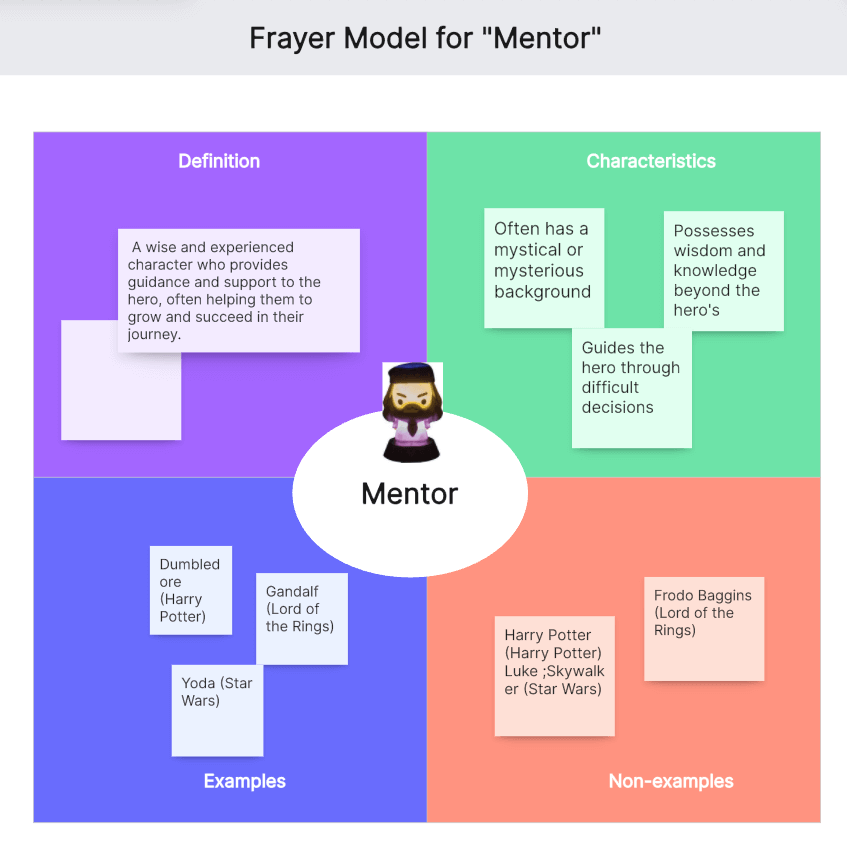
Definition: A wise and experienced character who provides guidance and support to the hero, often helping them to grow and succeed in their journey.
Essential Characteristics
- Possesses wisdom and knowledge beyond the hero's
- Often has a mystical or mysterious background
- Guides the hero through difficult decisions
- Provides crucial training or advice
- Sometimes sacrifice themselves for the hero’s success
- Helps the hero to discover their true potential
- Acts as a moral compass for the hero
Examples
- Gandalf (Lord of the Rings)
- Dumbledore (Harry Potter)
- Yoda (Star Wars)
- Mr. Miyagi (The Karate Kid)
- Mufasa (The Lion King)
Non-Examples
- Frodo Baggins (Lord of the Rings)
- Harry Potter (Harry Potter)
- Luke Skywalker (Star Wars)
- Daniel LaRusso (The Karate Kid)
- Simba (The Lion King)
Frayer Model for "Mountain"
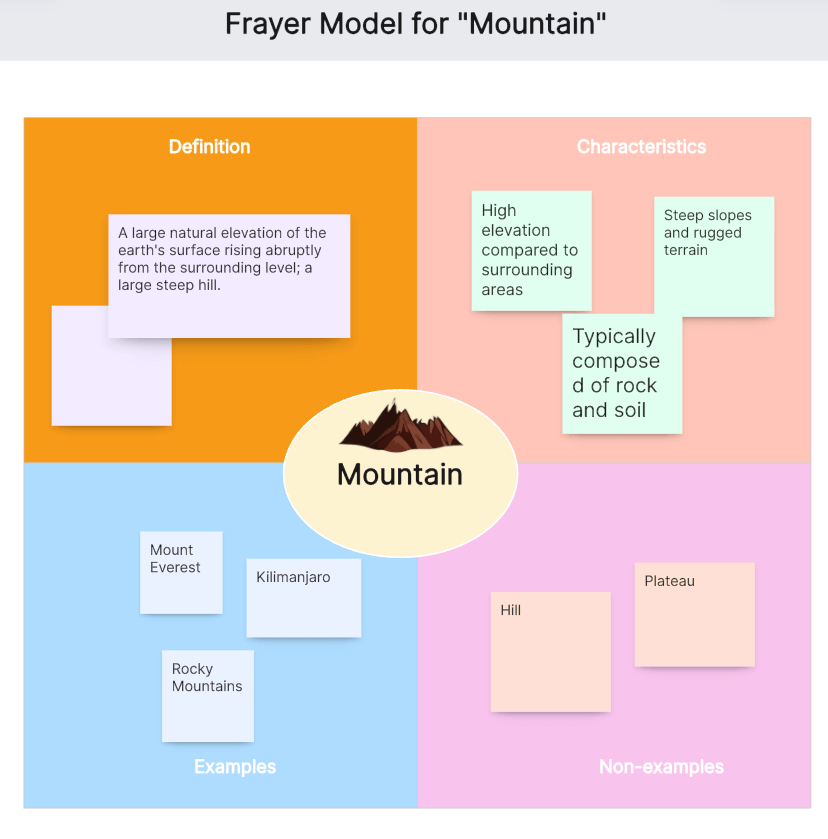
Definition: A large natural elevation of the earth's surface rising abruptly from the surrounding level; a large steep hill.
Essential Characteristics
- High elevation compared to surrounding areas
- Steep slopes and rugged terrain
- Typically composed of rock and soil
- Often formed by tectonic activity
- May have a peak or summit
- Can support diverse ecosystems depending on the altitude
Examples
- Mount Everest
- Kilimanjaro
- Rocky Mountains
- Andes
- Himalayas
Non-Examples
- Hill
- Plateau
- Valley
- Plain
- Canyon
Frayer Model for "Novel"

Definition: A long narrative work of fiction, usually written in prose, that explores human experiences through a connected sequence of events and characters.
Essential Characteristics
- Lengthy narrative with a detailed plot
- Includes complex characters and character development
- Structured into chapters or sections
- Can explore a wide range of themes and genres
- Often involves a central conflict and resolution
- Written in prose rather than poetry
Examples
- "Pride and Prejudice" by Jane Austen
- "1984" by George Orwell
- "To Kill a Mockingbird" by Harper Lee
- "The Great Gatsby" by F. Scott Fitzgerald
- "Moby-Dick" by Herman Melville
Non-Examples
- Short story
- Poem
- Play
- Essay
- Biography
Frayer Model for "Democracy"

Definition: A system of government where the citizens exercise power by voting, typically through elected representatives.
Essential Characteristics
- Citizens have the right to vote in elections
- Power is distributed among elected officials
- Majority rule with respect for minority rights
- Free and fair elections
- Protection of individual rights and freedoms
- Accountability of government officials
Examples
- United States
- India
- Germany
- Japan
- Australia
Non-Examples
- Monarchy
- Dictatorship
- Oligarchy
- Theocracy
- Totalitarianism
Frayer Model for "Photosynthesis"
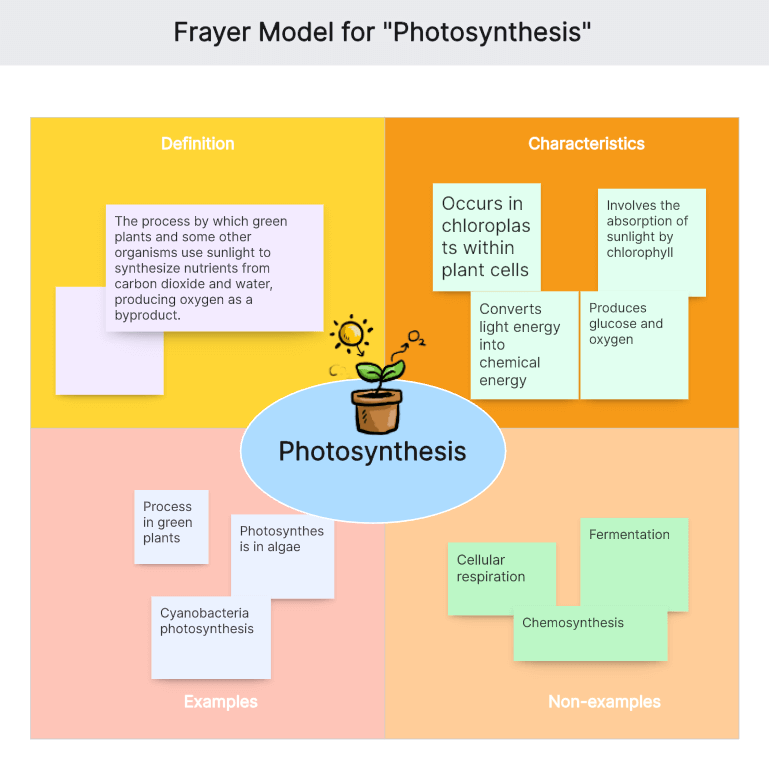
Definition: The process by which green plants and some other organisms use sunlight to synthesize nutrients from carbon dioxide and water, producing oxygen as a byproduct.
Essential Characteristics
- Occurs in chloroplasts within plant cells
- Involves the absorption of sunlight by chlorophyll
- Converts light energy into chemical energy
- Produces glucose and oxygen
- Requires carbon dioxide and water as inputs
- Fundamental process for sustaining life on Earth
Examples
- Process in green plants
- Photosynthesis in algae
- Cyanobacteria photosynthesis
- Occurs in leaves of plants
- Basis of the food chain
Non-Examples
- Cellular respiration
- Fermentation
- Chemosynthesis
- Decomposition
- Digestion
Frayer Model for "Revolution"
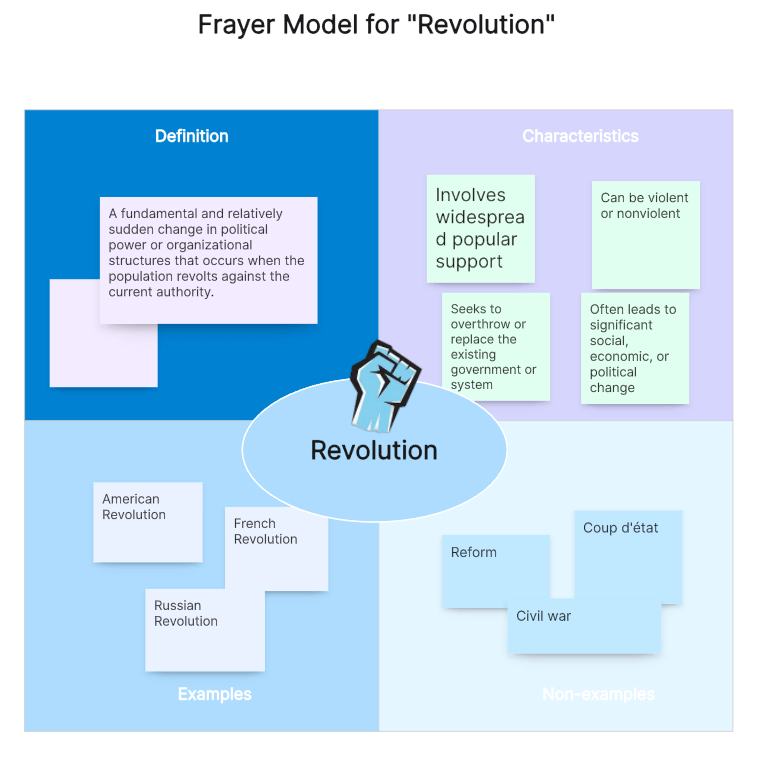
Definition: A fundamental and relatively sudden change in political power or organizational structures that occurs when the population revolts against the current authority.
Essential Characteristics
- Involves widespread popular support
- Can be violent or nonviolent
- Seeks to overthrow or replace the existing government or system
- Often leads to significant social, economic, or political change
- Driven by demands for rights, freedoms, or better conditions
- May be influenced by ideology or external factors
Examples
- American Revolution
- French Revolution
- Russian Revolution
- Cuban Revolution
- Iranian Revolution
Non-Examples
- Reform
- Coup d'état
- Civil war
- Election
- Peaceful transition of power
What is the Effectiveness of Using the Frayer Model for Vocabulary?
The Frayer Model has been proven to be an effective strategy for vocabulary acquisition and retention. Here's why:
1. Enhances Memory Retention
Research shows that breaking down information into manageable chunks, as the Frayer Model template does, improves memory retention. Students are more likely to remember vocabulary words when they understand not just what they mean, but how they are used and what they are not.
2. Improves Application Skills
By requiring students to provide examples and non-examples, the Frayer Model template helps them apply vocabulary words in various contexts. This skill is crucial for standardized tests, writing assignments, and real-world communication.
3. Facilitates Differentiated Instruction
The Frayer Model is adaptable for students with different learning needs. Teachers can modify the model to suit the proficiency level of each student, ensuring that all learners can benefit from the strategy.
4. Supports Collaborative Learning
The Frayer Model can be used as a group activity, promoting collaborative learning. When students work together to fill out the model, they engage in discussions that deepen their understanding and provide multiple perspectives on the word or concept.
Tips for Creating and Using Frayer Model Template
While the Frayer Model is straightforward, following these tips can help you maximize its effectiveness:
1. Choose Words Carefully
Select vocabulary words that are essential to the lesson and have complex meanings that require deeper understanding. Avoid overly simple words that may not benefit from the Frayer Model's structure.
2. Incorporate Visuals
Encourage students to include drawings, diagrams, or other visual elements in their Frayer Model. Visual aids can enhance understanding and make the model more engaging.
3. Use in Conjunction with Other Strategies
Combine the Frayer Model template with other instructional strategies, such as word maps or graphic organizers, to reinforce learning. This multi-faceted approach can help cater to different learning styles.
4. Encourage Group Work
Have students work in pairs or small groups to complete the Frayer Model. Collaborative work fosters discussion, critical thinking, and the exchange of ideas, all of which contribute to a deeper understanding of the vocabulary.
5. Review and Reflect
After completing the Frayer Model, take time to review it with the students. Discuss the examples, non-examples, and characteristics to ensure that everyone has a clear understanding of the word. Reflection can help solidify the knowledge gained.
Incorporating the Frayer Model into your vocabulary instruction can greatly enhance students' understanding and retention of new terms. To further streamline this process, Boardmix offers an intuitive platform that allows you to create and customize Frayer Model templates easily. With Boardmix, educators can collaborate in real time, share templates with students, and access a variety of tools to make learning more interactive and engaging. Whether you're teaching in a classroom or facilitating remote learning, Boardmix provides the flexibility and functionality needed to maximize the effectiveness of the Frayer Model.








